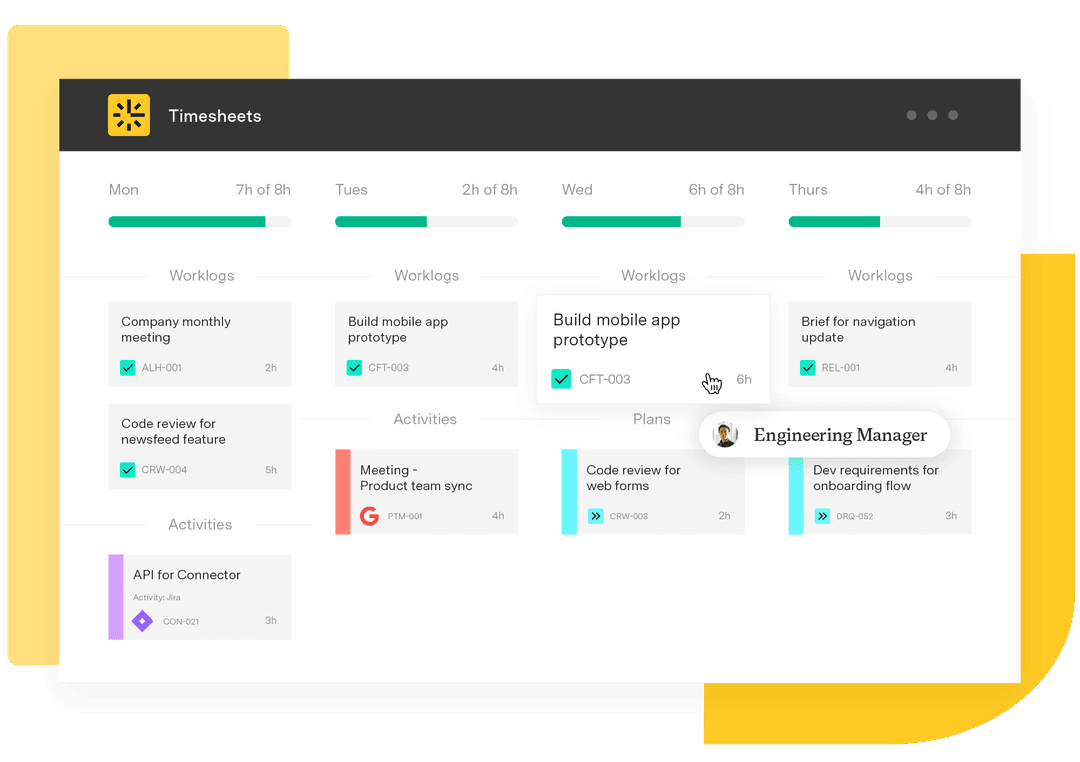Blog - Democratic leadership: A guide for collaborative teams
Tempo Team
In boardrooms, classrooms, and creative agencies alike, the days of leaders making decisions behind closed doors are fading. More organizations are moving toward democratic leadership, a style that gives team members a genuine voice in the process.
The idea isn’t about weakening leadership. On the contrary, strong leaders set the direction but make space for input, weighing multiple perspectives before deciding on the final path. The approach blends structure with collaboration and often produces solutions that a single viewpoint would miss.
In this guide, we’ll explain what democratic leadership is, when it works best, and the trade-offs it brings. We’ll also show you how Tempo’s tools help put these principles into practice by keeping progress visible and decision-making transparent.
What’s democratic leadership?
Democratic leadership, sometimes called collaborative leadership, is a leadership style in which all team members have a genuine say before decisions happen. Managers still have the responsibility of choosing a direction, but the process doesn’t start and end with them. Instead, they ask for ideas, listen to concerns, and factor in different perspectives before moving forward.
This participative leadership approach relies on three principles:
Collaboration: More than one voice shapes the outcome.
Transparency: Leaders explain the reasoning behind decisions instead of keeping things private.
Empowerment: People see their input reflected in outcomes, which fuels motivation and builds trust.
Democratic leadership examples
The democratic leadership style is most effective in settings where outcomes benefit from a mix of viewpoints, such as software teams deciding which features to build, faculty reviewing curriculum updates, or creative agencies pitching campaign concepts. In each case, the model adds value by drawing on collective input. Below are a few examples of democratic leadership in action, each showing how decisions improve when more perspectives guide the process.
Product development
Brainstorming sessions are a textbook case of democratic leadership: Every voice has weight before features are finalized. A junior developer might spot a usability gap that the product manager missed, while QA raises integration risks. By giving space to these perspectives, the team avoids costly rework and arrives at a stronger release plan.
Agile project management
Sprint retrospectives put democratic leadership into practice by giving each team member equal footing in shaping what comes next. Engineers highlight technical debt, customer success shares user feedback, and product owners adjust priorities accordingly. The backlog reflects group input instead of top-down directives.
Education
When schools revise curriculum, democratic leadership shows up in how teachers, administrators, and students all have a seat at the table. Teachers bring classroom realities, students explain what helps them learn, and administrators keep compliance in check. The final curriculum reflects collective input, not just a single authority.
Creative agencies
Campaign planning in agencies often demonstrates democratic leadership at its core. Strategists define goals, designers push for creativity, and media teams weigh in on reach and budget. Because leaders invite and balance these voices, the final pitch is both imaginative and practical, a decision that was collaboratively rather than dictated from the top.
Advantages of democratic leadership
No matter how new or seasoned, leaders who bring their teams into the conversation often see payoffs that go beyond better decisions. The culture of the workplace itself changes – people feel heard, ideas multiply, and collaboration grows stronger.
Higher morale and engagement
When employees have a real say in shaping their work, they feel respected and more invested in the outcome. People know their contributions matter, and that sense of ownership helps engage them more. It also improves retention while building a healthier workplace culture.
More innovative ideas
Different perspectives tend to produce better solutions than a single voice at the top. Leaders who run open brainstorming sessions or encourage cross-team input often uncover creative approaches that wouldn’t appear in a rigid hierarchy. A junior engineer, for instance, might suggest a shortcut during planning that saves weeks of work, an idea that surfaces only because the environment allows it.
Better-quality decisions
Leaders who involve their teams reduce blind spots and minimize risk by drawing on broader expertise. They also increase buy-in: Employees are more likely to support a decision they helped shape, even if their own idea didn’t win. That shared ownership translates into stronger follow-through once the decision is made.
Stronger teamwork and collaboration
Democratic leadership also improves how teams work together. It teaches people to listen, compromise, and use differences constructively rather than compete for attention. The result is better relationships between colleagues and stronger problem-solving skills across the group.
How to put democratic leadership into action: 5 steps
Adopting a democratic leadership style isn’t just about asking for opinions. It means creating an environment where people speak up, setting clear limits so conversations stay productive, and making sure decisions still move forward. Here’s how that plays out.
1. Create a culture of psychological safety
People share ideas when they know it won’t backfire. A leader who thanks someone for raising a tricky issue – or who handles disagreement without shutting it down – signals that it’s safe to speak up. Over time, that becomes part of the culture.
2. Clearly define the decision and its boundaries
Participation doesn’t mean every detail is negotiable. Good leaders spell out what’s on the table and what isn’t. A product manager, for example, might invite ideas on rollout strategy but make it clear that the budget is already set. That distinction helps keep discussions grounded.
3. Provide the necessary information
If you want meaningful input, people need context. Sharing reports, background notes, or lessons from previous projects ensures feedback is informed rather than guesswork. Otherwise, employees are reacting in the dark.
4. Listen actively and guide the discussion
Democratic leaders do more than collect opinions. They ask follow-up questions, surface trade-offs, and draw quieter voices into the mix. Remember, some of the best ideas come from people who don’t fight for airtime.
5. Communicate the final decision
In the end, responsibility still rests with the leader. What matters is explaining how the decision was reached and showing that feedback shaped the outcome. Even if not every idea makes it through, people trust the process when they see their input was taken seriously.
Disadvantages of democratic leadership
Democratic leadership has obvious appeal, but it's not without its challenges. Below are a few setbacks to keep in mind when applying this leadership style.
Slower decisions
Consensus takes time. A quick call that might take one manager five minutes can stretch into a half-hour debate with a team. In routine or low-stakes cases, that’s fine. When the clock is ticking, it’s not.
Conflict and social pressure
Open debate invites friction. Strong personalities often dominate, while quieter colleagues fall back. That can result in fewer real viewpoints on the table, even though the whole point was to expand them.
Too much ambiguity
When everyone is encouraged to weigh in, it’s easy to lose sight of who carries the ball. Without a clear handoff, decisions can stall, and execution gets messy.
Uneven expertise
Not every voice carries the same weight when the issue is highly technical. Treating all input as equal may bog down the process, or worse, lead to weak choices made for the sake of consensus.
Fostering collaboration and transparency with Tempo
Democratic leadership depends on trust: people share their ideas freely when they know their input will be heard and acted upon. Beyond goodwill, it requires visibility into how work, time, and resources are managed. Tempo brings those elements together inside Jira, giving leaders and teams a single place to connect feedback with real performance data.
Timesheets makes contributions visible by showing how time and effort are distributed across projects. Financial Manager ties budgets directly to that progress, turning numbers into a shared view of priorities. And with Capacity Planner, managers can schedule work and adjust plans in real time as feedback comes in. Together, these tools keep teams accountable, give leaders the visibility they need, and create space for collaboration without losing direction.
Build a workplace where people feel heard, valued, and aligned around the same goals – with Tempo.












































